Plant extracts in animal feed – How important is formulation?
Plant extracts are often all thrown into the same pot, when in fact there are many different types of herbs and spices that could be used in products formulated for the use in animal feed. Plus, there are a multitude of possibilities to combine them and additional factors that will differentiate products containing plant extracts formulated for the use in animal feed. So, the reality is they are not all the same.
by Gwendolyn Jones, Product Manager Gut Agility Activators
The type and combination of plant extracts is only one of the factors that determines the function and effectiveness of what is currently sold into animal feed as “plant extracts”. What looks promising in an in vitro experiment might not always be practical and cost-effective in vivo. The question will always be: have the plant extracts been tested at different dosages in the animal and in what species?
Here are 3 of the key factors that need to be considered when formulating and designing feed solutions based on plant extracts.
1.Function
Herbs and Spices have many different bioactive components with different properties and functions. Even their essential oils can have something like 80 different components. Plants have evolved to cope with stressors and many of these components have a protective role supporting the resilience of plants, but they also evolved to attract pollinators to propagate. So, when you combine plant extracts derived from a number of different herbs and spices you can have a all cocktail of bioactive substances and their effect will ultimately also be determined on synergistic effects and not just concentrations of individual components. New research technologies have facilitated a more in depth understanding of the mode of action of plant extracts and their components at the animal level. As a result, it is now possible to formulate plant extracts with a more accurate idea of the outcome for their function in the animal and animal response, rather just working in a black box approach. This is speeding up the process of product development and evaluation. It also provides more potential for differentiation in function between products through formulation know how within the category of plant extracts.
2.Taste
Most plant extracts have sensory properties and they come with a distinctive flavour. That in itself can determine how effective the product will be and how much of it you can apply to animal feed, because the flavour can affect feed intake not just in a positive way. For example, plant extracts with a strong bitter taste can lead to a lower acceptance of feed in pigs. Again, this will depend on dosage, but is it possible to apply the dosage required to achieve the desired effect in the pig without having a negative impact on feed intake? Only in vivo dose response trials will provide the answer. So, it is important to understand which plant extract compounds might have a negative impact on feed intake and find ways to determine the acceptable dose or mask their taste.
3.Concentration/dosage of plant extracts in animal feed
Concentrations of individual components in the formula and concentrations ultimately added to the feed determine the dosage required to achieve the desired response in the animal. Dose response trials are required to determine the optimal and most cost-effective dosage. As is the case with other types of feed additives more is not always better in terms of performance, but there will be a minimum dose required to have an impact on the animal.
These are only some of the factors to consider when formulating products with plant extracts. But they highlight that how they are formulated matters, and the buck stops with the animal.



